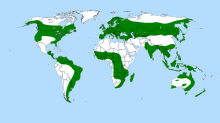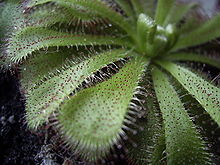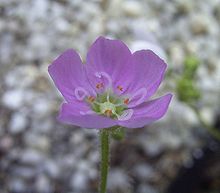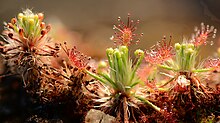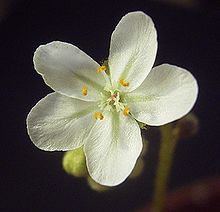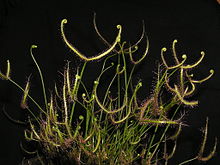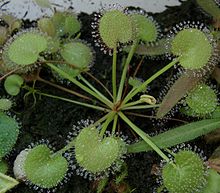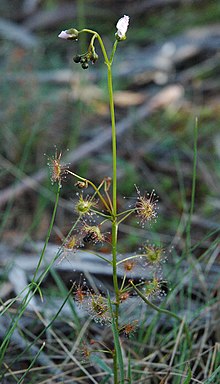Sundew
| Sundew | ||||||||||||
|---|---|---|---|---|---|---|---|---|---|---|---|---|

|
||||||||||||
| Systematics | ||||||||||||
|
||||||||||||
| Scientific name | ||||||||||||
| Drosera | ||||||||||||
| L. |
The genus sundew ( Drosera ) belongs to the family of the sundew plants (Droseraceae) and forms the second largest genus of carnivorous plants with over 200 species . Characteristic are the leaves of the plants covered with glue glands, which enable them to catch prey and thus to thrive even on very nutrient-poor soils.
The genus is distributed almost worldwide, the main distribution areas are Australia, South America and South Africa. Many of the species are endangered by humans. A few species, however, are valued as ornamental plants .
description
Sundew species are rarely annual, but mostly perennial herbaceous plants , rosette-forming, upright or climbing with a stature height of one to one hundred centimeters, depending on the species. However, climbing sundew species can reach a much greater length, over 3 meters have been reported ( Drosera erythrogynous ). They can be proven to be over 50 years of age. The genus is so specialized in the uptake of nitrogen by trapping insects that it completely lacks the enzyme nitrate reductase , at least in the dwarf sundew species, which plants normally need for the uptake of soil-bound nitrate . Vegetative reproduction takes place through above-ground runners, stolons , or - depending on the growth form - through the formation of nodules or brood scales .

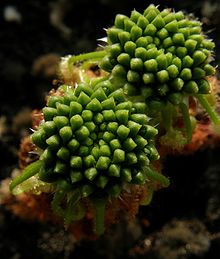
Growth forms
The genus can be divided into different growth forms:
- Tempered forms: This includes all species occurring in Europe. For wintering, the plants move into a hibernacle , a so-called hibernacle , from which they sprout again in spring (= hemicryptophyte ). Interestingly, there are also forms of some such species under subtropical to tropical conditions that do not go into hibernation and therefore do not develop hibernacles ( long-leaved sundew , medium sundew ).
- Subtropical forms: The plants have a year-round vegetation period under almost constant climatic conditions.
- Dwarf Drosera : A group of around 40 Australian species that are characterized by dwarfism, the formation of brood scales and the formation of thick hairs in the heart of the rosette. This serves the plant to protect itself from the intense sun in the Australian summer. It corresponds to the section Bryastrum .
- Tuberous Drosera : Over forty Australian species move into an underground tuber to survive an extremely dry summer, from which they sprout again in autumn. These so-called bulbous drosera are further divided into upright, climbing and rosette-shaped species. The group largely corresponds to the subgenus Ergaleium .
- Petiolaris complex : A tropical group of Australian species that live under consistently high temperatures, but in conditions of variable humidity. Some of the 14 species in the group have developed special strategies for this purpose, for example thick hair, which protects against dehydration and serves to collect condensation from the air; this is the case with the morning dew. It largely corresponds to the Lasiocephala section .
Although not defined by a growth habit in the strict sense, another grouping is often cited:
- Queensland Drosera : A small group of three closely related species ( Drosera schizandra , Drosera prolifera and Drosera adelae ) that thrive and are endemic in tropical rainforests in the north of the Australian state of Queensland in extremely high humidity and low light intensity . However, they prefer different microhabitats and never appear together.
root

The root system of most sundew species is weak. It mainly serves to anchor the plant in the ground and to absorb water; the roots are almost irrelevant for the supply of nutrients. Some South African species store water and nutrients in their roots. In some Australian species, tubers are used as storage organs for this purpose; they serve to survive the plant in extreme drought. The taproots of dwarf sundew species are often extremely elongated in relation to their size, a one-centimeter-tall plant can develop a taproot up to 15 centimeters long. Stem-forming dwarf sundew species often develop support roots in old age that grow from the crown down to the ground.
leaves

Within the genus, numerous, sometimes very different leaf shapes have developed, with or without a stalk. The most unusual form is certainly the one or more forked Drosera binata . Depending on the species, the entire trapping leaf is mobile to different degrees and thus supports the trapping process, so the Cape sundew ( Drosera capensis ) can bend its leaf by more than 360 ° and thereby almost completely enclose its prey. See also: Emergences at Drosera
Glandular or glue tentacles
Regardless of their shape, all sundew species are characterized by their tentacles on the leaves , covered with sticky secretions , which can be moved in all species of the genus. The glue tentacles on the leaf margin are often greatly elongated. These are stalked glands that secrete a sticky, sugary secretion whose shimmer attracts insects, which then stick to the secretion. The tentacles in the immediate vicinity of the prey then also lean in the direction of the catch and thus increase adhesion and subsequent digestion. The captured animals either die from exhaustion or choke on the viscous secretion that seeps into their trachea and blocks them. Meanwhile, the tentacles secrete enzymes such as esterase , peroxidase , phosphatase and protease , which now slowly decompose the prey and dissolve the nutrients it contains. The nutrients dissolved in this way are then absorbed by the glands on the leaf surface and used for the growth process. The latter can also be missing in some species, for example in Drosera erythrorhiza .
Quick tentacles
The term quick tentacle was coined by Jan Schlauer at the beginning of the millennium, because they can move upwards and at the same time be very fast. These are dry, particularly long tentacles on the edge of the leaf which, when touched, fling the prey backwards through a bend of 180 ° into the glue tentacles in the center of the leaf. This trap system is also known as a catapult glue trap. The movement takes place in a joint zone, but their function and morphology are different. In contrast to the glue tentacles that can move in all directions and stand vertically on the surface of the leaf, quick tentacles can only move upwards or downwards, but due to their broad base they can do so very powerfully and quickly. They only occur in the subgenus Drosera . Many species form quick tentacles at least as seedlings, but in adult plants they only occur in species with a basal rosette, while they are absent in upright species. Their speed, function and morphology differ in different sections. For the duration of the trapping process, times in the range of tenths of a second were measured for dwarf drosera (section Bryastrum ). The process is fastest in D. glanduligera , where it only takes 75 ms (for comparison: Venus flytrap : 100 ms). However, this type of tentacle works only once, as cells in the joint zone are destroyed by high hydraulic pressure. In all other species, the tentacles return to their original position after a while.
Non-glandular emergences

Some species ( section Arachnopus ) have developed modified tentacles in addition to their catching tentacles, some of which have an unexplained function. These excrete neither catch secretions nor enzymes and differ significantly from catch tentacles in size and structure. In the case of Drosera hartmeyerorum , they may serve to attract people with their striking color.
The emergences of Drosera indica, which are distributed over the entire leaf surface on the catch leaves, are between 0.1 and 1.0 mm small, mushroom-shaped and in Australian varieties have a hemispherical yellow head, while African varieties have a translucent , wavy plate-shaped head. These are so small that they are barely noticeable to the naked eye, making them visually attractive to insects is therefore rather unlikely.
In Drosera hartmeyerorum , the clearly visible, 3–4 mm large, bright yellow emergences are concentrated on the leaf base of the always dark red catch leaves and above the dark red crescent-shaped bracts of the inflorescence, where they form a real chain of lights. They show a complex structure: a lens-like structure made of honeycomb-shaped, transparent giant cells sits as the head on a transparent tentacle stem, which focuses incident light on a compact, bright yellow center. If light now falls on the emergence heads, they light up bright yellow. In particular, the “lens tentacles” sitting on the red bracts of the inflorescence create a real yellow light chain when the light falls. Since insects have a different color perception, the dark red of the plant is an almost black background for them, against which the emergences shine richly in contrast.
Flowers, fruits and seeds

As is usual with almost all carnivores , the flowers of the sundew are usually on very long inflorescences above the plant so that possible pollinator insects are not caught by the leaves. The mostly unborked inflorescences are usually wraps , the flowers of which open individually and usually only bloom briefly. The most important factor for the opening of the flower is the intensity of the sun; the inflorescences are also "heliotropic", so they turn towards the sun. Furthermore, closure of the flowers upon mechanical stimulation was observed.
The radial , hermaphrodite flowers are always simple and fivefold; only two species fall out of line in this regard, namely the fourfold Drosera pygmaea and the eight to twelvefold Drosera heterophylla .
The flowers of most species are extremely small (less than 1.5 cm), but a few ( Drosera regia and Drosera cistiflora ) have flowers up to four centimeters in diameter. As a rule, sun pale flowers are white or pink. A somewhat greater variety of colors prevails in the Australian and African species; there are also occasional orange ( Drosera callistos ), red ( Drosera cistiflora ), yellow ( Drosera zigzagia ) or even purple-metallic colored ( Drosera microphylla ).
The ovaries are on top. There are fruit capsules made with very many small seeds. Many sundew species are self-pollinating; large quantities of seeds are often produced. The seeds are black, dusty and light-germinating , but quickly lose their ability to germinate. Almost all species are wind spreaders , with a few species ( Drosera felix , Drosera kaieteurensis ) there is a special form of distribution in which the seeds are thrown out of the seed capsule by the "impact" of a raindrop (raindrop or splash cup spread). Types of temperate zones are frost germs .
distribution
The areas of the genus extend from Canada in the north to New Zealand in the south. The main distribution areas are Australia with almost 50 percent of all species , South America with twenty to thirty species and southern Africa . A few species occur extensively in Eurasia and North America; these areas are, however, to be regarded as marginal areas of the genus, as are the outermost arctic occurrences. Possibly the evolutionary separation of the genus is due to the drifting apart of the continents that formerly belonged together as the supercontinent Gondwana , but a subsequent dispersion over great distances is also discussed. The origin of the genus Australia or Africa is assumed.
In Europe there are only three species (besides the natural hybrids Drosera × obovata and Drosera × eloisiana ): the round-leaved sundew ( D. rotundifolia ), the long-leaved sundew ( D. anglica ) and the medium-sized sundew ( D. intermedia ).
The genus is often referred to as cosmopolitan , i.e. occurring worldwide. The botanist Ludwig Diels , author of the only monograph on the family so far , described this, however, as a “serious misunderstanding of their highly peculiar distribution conditions”, although the sundew species “occupied a considerable part of the earth's surface”. In particular, he pointed to their lack in almost all arid zones, numerous rainforest areas , on the American Pacific coast, in Polynesia, the Mediterranean and North Africa, as well as the very low biodiversity in temperate zones, for example Europe and North America.
Habitats
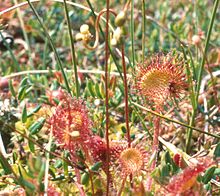
Sundew species usually grow in seasonally humid , rarely permanently wet areas with nutrient-poor, acidic soils and lots of sun, e.g. B. in moors , heaths , swamps , in wallum , fynbos , on island mountains , but also in marshland and on the banks of flowing waters. Many forms grow together with peat mosses , which remove nutrients from the subsoil and at the same time acidify it, thereby hindering the growth of potential competitors.
However, the genus is very variable in its habitat requirements; In individual cases, species even manage to settle in very atypical areas such as rainforests, deserts (e.g. Drosera burmannii and Drosera indica ) or in biotopes with strong shading (Queenslanddrosera). The temperate species that develop hibernacles over winter also represent such a form of adaptation to different habitats, as the species of the genus usually prefer warm climates and are only partially frost-hardy.
Danger

All domestic Drosera species are protected in Germany, Austria and Switzerland. In other European countries such as Finland , Hungary , France or Bulgaria are Drosera TYPES protected by law. In Central Europe, for a long time, the use of habitats through drainage and peat removal represented the main threat. As a result, the populations of these sensitive plants have now disappeared or died out in numerous regions. Experience has shown that once lost locations can no longer be regained by resettlement, since the ecological scope is very limited with regard to location factors. Although the decline in sundew has been slowed down through the increased legal protection of the moors and Anmoore as well as efforts to renaturalize them, most sundew species are still endangered. The relatively inconspicuous appearance as well as the small, low growth of these plants generally make protection efforts on site more difficult. Sundew plants are often overlooked or not recognized at all.
In two of the three main distribution areas, in South Africa and Australia, the sundew habitats there are subject to strong human pressure. In particular, expanding settlement areas ( Queensland , Perth , Cape Town ) and the draining of wetlands for agriculture and forestry endanger the populations that often only exist in isolated areas. Due to the droughts that have dragged on for more than ten years in parts of Australia and are probably a consequence of global warming, locations are increasingly becoming dry, which also poses an indirect threat to the species there.
Species that can only be found in extremely narrowly defined locations are subject to the greatest risk of total loss due to the collection of wild plants. Due to massive overexploitation for export in Madagascar , Drosera madagascariensis is considered to be highly endangered, 10–200 million plants are collected there for marketing purposes every year.
Phylogenetics
The following cladogram shows the relationships between the various sections or sub-genres based on the analyzes by Rivadavia et al. a. 2003. The monotypical section Meristocaulis was not included in the investigations, so that its position in this system is unclear, but more recent investigations place it in the vicinity of the section Bryastrum or integrate it there. Since the Drosera section is polyphyletic , it appears several times within the cladogram (*) .
This phylogenetic investigation has made the need for a revision of the genus even clearer.
|
|
|
||||||||||||||||||||||||||||||||||||||||||||||||||||||||||||
|
|
Systematics
According to Seine & Barthlott , 1994, the genus Drosera , supplemented by revisions and new descriptions, is divided into three sub-genera and eleven sections, based on morphological features.
For decades, more and more new species have been discovered and described, in the 1940s only a little over 80 species were known, in 2018 already 244. Numerous Australian species were first described by the Australian Allen Lowrie . His taxonomy in this regard was questioned in 1996 by the German botanist Jan Schlauer , but this did not prevail.
Sections and species of the genus Drosera
| Subgenus Drosera | |||||||||||||||||||||||||||||||||||||||||
|---|---|---|---|---|---|---|---|---|---|---|---|---|---|---|---|---|---|---|---|---|---|---|---|---|---|---|---|---|---|---|---|---|---|---|---|---|---|---|---|---|---|
|
| Subgenus Ergaleium DC. | ||||||||||||
|---|---|---|---|---|---|---|---|---|---|---|---|---|
|
| Subgenus Regiae Seine & Barthlott |
|---|
|
| Further newly described species (without assignment to a subgenus) |
|---|
|
use
Medicinal plant
Sundew contains various medically effective ingredients, namely naphthoquinone derivatives (plumbagin, droseron, ramentaceon) and flavone glycosides (quercetin, myricetin, camphor oil).
Sundew was used against dry coughs, to strengthen the heart and as an aphrodisiac, but also to treat sunburn and freckles. As cough medicine, it was still used in 200-300 approved medicinal products in the early 1990s, mostly in combination with other active ingredients. Nowadays, some of the preparations from homeopathy are also represented, with sundew and other active ingredients being used as the mother tincture .
In Germany, however, wild collections have now been dispensed with; Instead, either areas in Madagascar, Spain, France, Poland and the Baltic States are harvested or sundew from German breeders is used, in particular the fast-growing species Drosera madagascariensis , Drosera ramentacea , but also the round-leaved and mean sundew .
Tissue culture
The sticky secretions ( adhesive substances ) formed by the sundew are already used in biomedicine . They are a natural hydrogel and are therefore biocompatible and tissue-like. Since cells stick together with the secretion, it is ideal for growing tissue.
Ornamental plants
Because of their carnivory and the graceful trapping leaves, sundew species are popular ornamental plants . Most species, however, have only limited market opportunities due to the difficult keeping conditions or the complicated reproduction. However, in addition to the Venus flytrap, a few robust species are now available as common carnivores for the mass market in many garden centers or hardware stores, in particular the Cape sundew and Drosera aliciae .
The other sundew species are also cultivated by a global circle of collectors several thousand strong; almost all species are currently in culture. Since many sundew species have very narrow distribution areas and are also rare in these, this has contributed to the decline and endangerment of some species due to heavy collections.
Sundew species as food
With the Australian Aborigines , the tubers of the native tuberous drosera are a popular food.
Etymology. history

The botanical name comes from the Greek "δρόσος", "drosos" for "dew". The German name is a translation of the older botanical name "ros solis". All these names are derived from the shiny appearance of the numerous drops of glandular secretion at the tip of the tentacles , which are reminiscent of morning dew drops.
In 1539 Hieronymus Bock described native sundew species:
“You can find beautifully vnnd noble Jungfraw hor on the gantz moſichten / and always wet knowledge ſo lie in the wild worlds between the mountains / watch / namely in the winter month / when you ſt the smooth brown geel Hörlin fingers long / with ſeinem gypffel (which I compare to a Weyſſen korn) besides the wet Moß wachſen in the lazy mats or brůch wiſen / the ſelbig Hörlin has its bletlin brown-red color on the Moßausgeſpreyt three or iiij. not much bigger / then the Mörlynſen but longer and ſpitzer. "
After Bock sundew species were, like the Golden maidenhair moss in the 16th century. Mainly in sympathy magic of folk medicine used. From the perspective of learned medicine, he assigned it to the "adianton" described by Dioscurides . After that, they had the following effects: driving urine and urinary tract stones, promoting hair growth, healing diseases of the breast, liver, spleen and skin.
The alchemists used sundew species, golden maidenhair moss and celandine to represent the materia prima . The selection criterion was the golden-yellow color of these plants. Like the corn dew , the alchemists also regarded the drops of glandular secretion from the sun dew plant ("ros solis") as "water impregnated with astral seeds".
proof
- Wilhelm Barthlott, Stefan Porembski, Rüdiger Seine, Inge Theisen: Carnivores. Biology and culture of carnivorous plants . Eugen Ulmer, Stuttgart (Hohenheim) 2004, ISBN 3-8001-4144-2 .
- A. Correa, D. Mireya, Tania Regina Dos Santos Silva: Drosera (Droseraceae). (= Flora Neotropica Monograph. Volume 96). New York 2005, ISBN 0-89327-463-1 . (spanish, english)
- Charles Darwin : Insectivorous Plants. Stuttgart 1876.
- Ludwig Diels : Droseraceae. In: Adolf Engler (ed.): The plant kingdom. 4, 112, 1906, p. 109.
- Allen Lowrie : Carnivorous Plants of Australia. Volumes 1-3, Nedlands, Western Australia, 1987-1998. (English)
Individual evidence
- ↑ Phil Mann: The world's largest Drosera . In: Carnivorous Plant Newsletter . tape 30 , no. 3 , October 22, 2001, p. 79 ( cephalotus.net ( memento from September 29, 2011 in the web archive archive.today )). The world's largest Drosera ( Memento of the original from September 29, 2011 in the web archive archive.today ) Info: The archive link was automatically inserted and not yet checked. Please check the original and archive link according to the instructions and then remove this notice.
- ^ Wilhelm Barthlott, Stefan Porembski, Rüdiger Seine, Inge Theisen: Carnivores. Biology and culture of carnivorous plants . Eugen Ulmer, Stuttgart (Hohenheim) 2004, ISBN 3-8001-4144-2 , pp. 102 .
- ↑ JS Pate, PS Karlsson: Contrasting effects of supplementary feeding of insects or mineral nutrients on the growth and nitrogen and phosphorus economy of pygmy species of Drosera . In: Oecologia . tape 92 , 1992, pp. 8-13 .
- ^ Richard Nunn, Greg Bourke: An account of Drosera section Prolifera . In: International Carnivorous Plant Society (ed.): Carnivorous Plant Newsletter . tape 46 , no. 3 , September 2017, p. 92-99 ( carnivorousplants.org [PDF]).
- ^ Wilhelm Barthlott, Stefan Porembski, Rüdiger Seine, Inge Theisen: Carnivores. Biology and culture of carnivorous plants . Eugen Ulmer, Stuttgart (Hohenheim) 2004, ISBN 3-8001-4144-2 , pp. 41 .
- ^ I. Hartmeyer, SRH Hartmeyer: Snap-Tentacles And Runway Lights . In: Carnivorous Plant Newsletter (ICPS) . tape 39 , no. 4 , December 1, 2010, p. 101-113 ( researchgate.net ).
- ^ Siegfried RH Hartmeyer, Irmgard Hartmeyer: Several pygmy Sundew species catapult-flypaper traps with repetitive function possess, indicating a possible evolutionary change into aquatic snap traps similar to Aldrovanda . In: ICPS (ed.): CPN . tape 44 , no. 4 , 2015, p. 172-184 ( carnivorousplants.org [PDF]).
- ↑ Simon Poppinga, Siegfried Richard Heinrich Hartmeyer, Robin Seidel, Tom Masselter, Irmgard Hartmeyer, Thomas Speck: Catapulting Tentacles in a Sticky Carnivorous Plant . In: PLOS ONE . tape 7 , no. 9 , September 26, 2012, p. e45735 , doi : 10.1371 / journal.pone.0045735 , PMID 23049849 .
- ↑ A complete documentation can be found on the DVD Drosera: Schnelltentakel und Landescheinwerfer. as well as in: Das Taublatt. 3, 2006, pp. 4-9.
- ↑ Kazuki Tagawa, Mikio Watanabe, Tetsukazu Yahara: A sensitive flower: mechanical stimulation induces rapid flower closure in Drosera spp. (Droseraceae): RAPID FLOWER CLOSURE IN DROSERA . In: The Society for the Study of Species Biology (Ed.): Plant Species Biology . 2018 ( researchgate.net ).
- ↑ a b c F. Rivadavia et al. a .: Phylogeny of the sundews, Drosera (Droseraceae), based on chloroplast rbcL and nuclear 18S ribosomal DNA sequences . In: Am J Bot. Band 90 (1) , January 2003, p. 123-130 .
- ↑ a b Ludwig Diels: Droseraceae. In: A. Engler (Ed.): The plant kingdom. 4, 112, 1906, p. 109.
- ↑ World Wildlife Fund Germany, TRAFFIC Germany (ed.): Drosera spp. - Sundew. 2001, p. 5, [1] (PDF).
- ^ Rüdiger Seine, Wilhelm Barthlott: Some proposals on the infrageneric classification of Drosera L. Taxon. Volume 43, No. 4, 1994, pp. 583-589.
- Jump up ↑ Allen Lowrie: A taxonomic revision of Drosera section Stolonifera (Droseraceae), from south-west Western Australia . In: Nuytsia . tape 15 , no. 3 , December 2005, p. 355-393 ( gov.au [PDF]).
- ↑ Allen Lowrie, John G. Conran: A revision of the Drosera omissa / D. nitidula complex (Droseraceae) from south-west Western Australia. In: Taxon. Volume 56, 2007, pp. 533-544.
- ^ Günter: Sonnentau In: Natur und Volk. Volume 78, Issue 1/3, Frankfurt 1948, pp. 32-37.
- ↑ a b c d e f g h i j k l m n o p q r s t u v w x y z aa ab ac ad ae af ag ah ai aj ak al am an ao ap aq ar as at au av aw ax ay az ba bb bc bd be bf bg bh bi bj bk bl bm bn bo bp bq br bs bt bu bv bw bx by bz ca cb cc cd ce cf cg ch ci cj ck cl cm cn co cp cq cr cs ct Rafaël Govaerts (Ed.): Drosera. In: World Checklist of Selected Plant Families (WCSP) - The Board of Trustees of the Royal Botanic Gardens, Kew . Retrieved October 31, 2018.
- ↑ Jan Schlauer: A dichotomous key to the genus Drosera L. (Droseraceae) . In: Carnivorous Plant Newsletter . tape 25 , no. 3 , September 1996, p. 67-88 ( carnivorousplants.org [PDF]).
- ↑ Michael T. Mathieson & Simon L. Thompson, Queensland Department of Environment & Science: Drosera buubugujin MTMathieson (Droseraceae, Drosera section Prolifera CTWhite), a spectacular new species of sundew from the Cape York Peninsula bioregion . In: Austrobaileya . tape 10 , no. 4 , April 20, 2020, p. 549-557 ( gov.au [PDF]).
- ↑ a b c A. Lowrie, JG Conran: A review of Drosera whittakeri s. lat. (Droseraceae) and description of a new species from Kangaroo Island, South Australia. In: Telopea. 12 (2), 2008, pp. 147-165.
- ↑ Scary, beautiful and bizarre. on: orf.at , May 23, 2016, accessed May 23, 2016.
- ↑ C. Ayuga et al .: Contribución al estudio de flavonoides en D. rotundifolia L. In: An R Acad Farm. 51, 1985, pp. 321-326.
- ^ H. Wagner et al.: Immunological investigations of naphthoquinone-containing plant extracts, isolated quinones and other cytostatic compounds in cellular immunosystems. In: Phytochem Soc Eur Symp. 1986, p. 43.
- ↑ J. Vinkenborg et al.: De aanwezigheid van hydroplumbagin-glucoside in Drosera rotundifolia . In: Pharmaceutisch Weekblad . tape 104 , no. 3 , 1969, ISSN 0031-6911 , p. 45-49 , PMID 5774641 .
- ↑ N. Sampara-Rumantir: Rossoliside. In: Pharm Weekbl. 106, 1971, pp. 653-664.
- ↑ H. Schilcher, M. Elzer: Drosera (Sundew): A proven antitussive. In: Journal of Phytotherapy . 14, 1993, pp. 50-54.
- ↑ homoeopathie-online.info Information from the German Central Association of Homeopathic Doctors, accessed on December 16, 2016
- ↑ homoeopathie-online.info accessed on December 16, 2016
- ↑ erkaeltet.info Information from DeGiN - German Society for Health Information in the Network mbH, accessed on December 16, 2016
- ↑ Time. No. 19, May 7, 2015.
- ^ Wilhelm Barthlott, Stefan Porembski, Rüdiger Seine, Inge Theisen: Carnivores. Biology and culture of carnivorous plants . Eugen Ulmer, Stuttgart (Hohenheim) 2004, ISBN 3-8001-4144-2 , pp. 100 .
- ↑ Helmut Genaust: Etymological dictionary of botanical plant names. 3rd, completely revised and expanded edition. Birkhäuser, Basel / Boston / Berlin 1996, ISBN 3-7643-2390-6 (reprint ISBN 3-937872-16-7 ).
- ↑ July
- ↑ Hieronymus Bock . New Kreütter book. Strasbourg 1539, book I, cap. 181. (digitized version)
- ↑ Paul Sartori: Abdontag. In: Concise dictionary of German superstition . I / 21.
- ^ Hanns Bächtold-Stäubli: Dismiss. In: Concise dictionary of German superstition . I / 123.
- ^ Heinrich Marzell : Widerton. In: Concise dictionary of German superstition . IX / 559.
- ↑ Julius Berendes : Des Pedanius Dioskurides medicament theory in 5 books. Book IV, Enke, Stuttgart 1902, Cap. 134. (digitized version)
- ^ Otto Brunfels : Contrafeyt Kreüterbuch. Strasbourg 1532, p. 240. (digitized version)
- ↑ Hieronymus Brunschwig : Liber de arte distillandi de compositis. Strasbourg 1512, sheet 27va. Quinta essentia from the krut called Celidonia. (Digitized version)
- ^ Heinrich Marzell : Sundew. In: Concise dictionary of German superstition . VIII / 74.
- ^ Heinrich Khunrath : Medulla distillatoria et medica renovata et augmentata . Bibliopolium Frobenianum, Hamburg 1605, p. 274: De Rore solis or von dem Sonnentaw. (Digitized version of the Bavarian State Library)
- ↑ Claus Priesner, Karin Figala (Ed.): Alchemie. Lexicon of Hermetic Science. Beck, Munich 1998, p. 239.
further reading
- Charles Darwin: Insectivorous Plants . In: Ch. Darwin's collected works. Volume 8, E. Schweizerbart'sche Verlagshandlung (E. Koch), Stuttgart 1876; Text of the German edition on Wikisource

